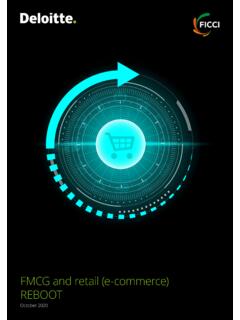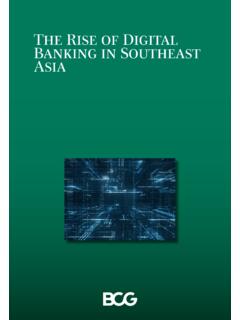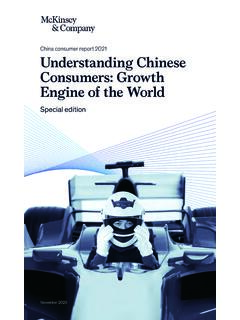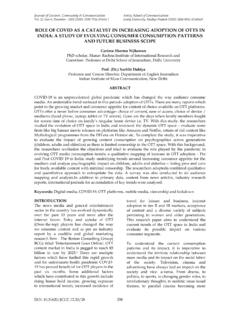Transcription of A wider circle digital lending and the changing landscape ...
1 A wider circle digital lending and the changing landscape of financial inclusion November 20192 PwC | A wider circle : digital lending and the changing landscape of financial inclusion In the past few years, India s economic performance has largely been steady, and it has been able to hold ground, despite frequent bouts of external as well as internal risks. However, the latest GDP data from various agencies points towards moderating growth levels. In order to regain a consistent 7 8 % growth rate, the role of medium, small and micro enterprises (MSMEs) is very critical.
2 However, due to their informal nature of operations, MSMEs lack access to formal credit as banks face several challenges in credit risk assessment owing to lack of financial information, historical cash flow data, etc. Assessing the creditworthiness of an MSME can be difficult due to information asymmetry, particularly with respect to financial performance of the business. Consequently, MSMEs are plagued by a massive credit demand-supply mismatch. As per estimates, the overall demand for both debt and equity finance by Indian MSMEs was around INR trillion, of which the debt demand alone was INR trillion and formal sources catered to only 16% of the total MSME debt, INR trillion.
3 With the Government of India (GoI) and regulators pushing for improved digital financial infrastructure, digital lending has provided a strong impetus to financial inclusion, especially helping borrowers who are otherwise unlikely to benefit from formal sources of finance. New lending platforms are transforming credit evaluation and loan origination, as well as opening consumer lending to non-traditional sources of capital. Many emerging innovations leverage advanced algorithms and computing power to automate activities that were once highly manual, allowing them to offer cheaper, faster, and more scalable alternative financial products and services.
4 The major business opportunities in the FinTech lending industry are cluster-centred funding, point-of-sale (POS)-based lending , peer-to-peer (P2P) lending , invoice-based lending , cash flow-based lending and online microcredit. A mix of traditional credit facilities from banks, NBFCs and innovative financing mechanisms from new age digital lenders will be critical for the growth of the MSME sector. Collaborative strategies can lead to better outcomes for banks and FinTechs by helping both develop and refine productive ways to evolve and serve MSMEs better.
5 Some positive outcomes of FinTech-bank partnerships are already visible, and these engagements should be further nurtured and strengthened. The low level of financial inclusion is a barrier to socio-economic development in developing countries. Financial inclusion can be better achieved with digital technology. digital technology improves the accessibility and affordability of financial services for the previously unbanked or underbanked individuals and MSMEs. Some of the new enablers for furthering financial inclusion are account aggregator models and public credit registries, and a lot would also depend on how the digital on-boarding and know your customer (KYC) processes of MSMEs and individuals evolve.
6 FICCI s FinTech Committee has been working closely with GoI and regulators to promote digital financial inclusion in the country. The conference provides an opportunity for further deliberations on the subject and I wish the FICCI team would also like to thank the team from PwC India for putting together this report and being the knowledge partner for the conference. Message from FICCIS udhakar Ramasubramanian Co-Chair, FinTech Committee, FICCI3 PwC | A wider circle : digital lending and the changing landscape of financial inclusionVivek Belgavi FinTech Leader and Partner, Financial TechnologyMessage from PwCOne of the key imperatives for the further advancement of the Indian economy is the need for inclusive growth, and opportunities for participation and contribution from all sections of the society.
7 This is currently a challenge owing to the limited access to financial services and products available to rural populations and low-income strata, together with a lack of financial literacy and awareness. These factors are impeding the inclusive financial growth of country. Facilitating an inclusive financial ecosystem is a significant part of the development agenda for social and economic progress. Moreover, within the larger sphere of financial inclusion, access to capital and borrowing opportunities is a key component that needs to be addressed in order to financially empower and drive traditionally underserved there are many top-down approaches to widening inclusion, there is a need for more organic financial models that align with standard economic incentive paradigms, apart from government rules and regulatory mandates, for such inclusiveness to be truly sustainable.
8 Technological advancements and their rapid adoption by lending companies have helped in realising novel, technology-based platforms, lean and agile business models, and innovations in delivering financial services, particularly in the lending space. Such advancements are now providing financial services players with the ability to reach underserved markets without forgoing economic and profitable report aims to provide incumbent banks, non-banking financial companies (NBFCs), new-age FinTech lenders, regulators, industries and other stakeholders with a comprehensive view of the FinTech lending landscape in India, and helps to understand key market trends, drivers and enablers of the ecosystem, emerging technologies in the lending sector and players operating in the would like to thank the Federation of Indian Chambers of Commerce and Industry (FICCI)
9 For organising this conference and inviting PwC India as a knowledge partner to share its vast experience of working with the Indian economic, business and regulatory sectors and strive towards achieving greater financial PwC | A wider circle : digital lending and the changing landscape of financial inclusion Executive summary Financial inclusion has been an important part of GoI s pro-growth economic policy measures and initiatives. Financial inclusion can pave the way for poverty reduction, financial stability and economic development for all sections of the society.
10 Lack of access to financial services is underpinned by factors such as lack or easy access to banking services, economic unviability from a demand and supply side, and cultural as well as regulatory factors. Application of pioneering technologies, advances in and adoption of GoI s IndiaStack infrastructure and innovative business models can foster products and services that enable growth and efficiency to overcome such impediments, contributing to improved and sustainable financial an evolving economy like India, FinTech lenders must navigate multi-faceted webs of compliances, regulations and the current domestic and global macroeconomic environment.
















